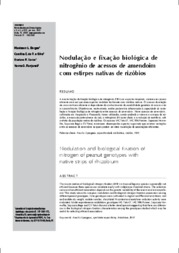Nodulação e fixação biológica de nitrogênio de acessos de amendoim com estirpes nativas de rizóbios.
Nodulação e fixação biológica de nitrogênio de acessos de amendoim com estirpes nativas de rizóbios.
Author(s): BORGES, W. L.; SILVA, C. E. de R. e; XAVIER, G. R.; RUMJANEK, N. G.
Summary: A maximização da fixação biológica de nitrogênio (FBN) em espécies tropicais, costuma ser pouco eficiente uma vez que essas espécies nodulam facilmente com rizóbios nativos. 0 sucesso da seleção de uma simbiose eficiente é dependente do conhecimento da variabilidade genética do macro e do microssimbionte. Objetivou-se, neste estudo, avaliar parâmetros relacionados à capacidade de nodu-lação e fixação biológica de nitrogênio entre acessos de amendoim. Nove acessos de amendoim, cultivados em Aargissolo e Planossolo, foram utilizados, sendo avaliado o número e a massa de nó-dulos, a massa da parte aérea e da raiz, o nitrogênio (N) acumulado, e a redução de acetileno, sob o efeito da população nativa de rizóbios. Os acessos lAC Tatu-ST, lAC 886 Runner, Sapucaia Verme-Iha, Sapucaia Bege e CV Tatuí, mostraram desempenho superior sugerindo que existem variações entre os acessos de amendoim as quais podem ser úteis na seleção de associações eficientes. The maximization of biological nitrogen fixation (BNF) in tropical legume species is generally not efficient because these species can nodulate easily with indigenous rhizobial strains. The selection success of an efficient association depends on the genetic variability of the macro and microsymbi-onto This study aimed to compare nodulation and biological nitrogen fixation parameters among different peanut genotypes. Nine genotypes were cultivated in Argisol and Planosol and shoot, root and nodule dry weight, nodule number, shoot total N content and acetylene reduction activity were evaluated. Under espontaneous nodulation, genotypes lAC Tatu-ST, lAC 886 Runner, Sapucaia Ver-melha, Sapucaia Bege and CV Tatuf showed a better development suggesting that there are differen-ces in the biological nitrogen fixation characteristics among the genotypes studied which may be useful for selecting efficient associations.
Publication year: 2007
Types of publication: Journal article
Unit: Embrapa Agrobiology
Keywords: Amendoim, Arachis Hypogaea, FBN, Fixação biológica de nitrogênio, Rhizobium
Observation
Some of Embrapa's publications are published as ePub files. To read them, use or download one of the following free software options to your computer or mobile device. Android: Google Play Books; IOS: iBooks; Windows and Linux: Calibre.
Access other publications
Access the Agricultural Research Database (BDPA) to consult Embrapa's full library collection and records.
Visit Embrapa Bookstore to purchase books and other publications sold by Embrapa.

